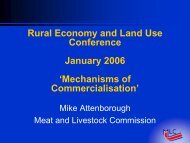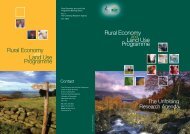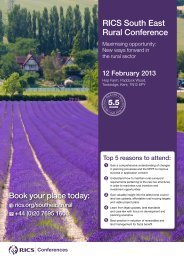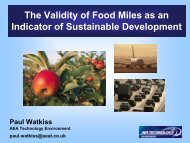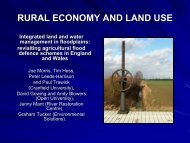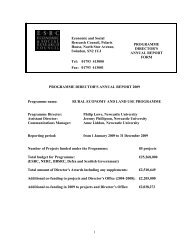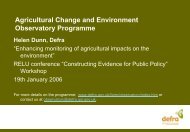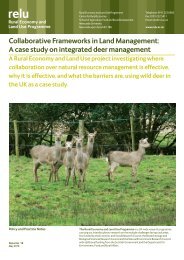Professor Gareth Edwards-Jones
Professor Gareth Edwards-Jones
Professor Gareth Edwards-Jones
- No tags were found...
Create successful ePaper yourself
Turn your PDF publications into a flip-book with our unique Google optimized e-Paper software.
Four reasons to go local
1. A belief that local supply chains are sociallyand economically beneficial‘Go local is the key’says Jules PrettyNew Scientist, P. 175 March 2005
2. Anti globalisation viewpoint
3. The environmental argument
4. ‘Non tariff trade barriers’ or‘protectionism’.‘Grow local, buy local, eat local’.‘Y Tir’ – the newspaper of the Farmers Union of Wales,November 2005.
Deliberately provocative statement• Very few of the advocates of local food actually haveminimising climate change, or even environmental damagein general, as their primary objective when advocating localfood systems.• Rather they are using the climate change issue as supportfor their real primary viewpoints which are complex andvaried.
TEST: If I could bring you your food without emittinggreenhouses gases (e.g. neo sailing ships) would youchange your support for local food?‘Cutty Sark’ byMontague Dawson
Environmentally and socially awarecitizens would seek to minimise the overalladverse impact of the food system – andnot just the food miles.They would also seek to maximise thebenefits of the food system.To assume ‘local’ is always best in theabsence of evidence is a leap of faith.
Conceptual model – natural systems• Three food items: carrots, wheat, lamb• The growing of each food item is associated with oneparticular environmental impact, the severity of which varieswith local soil and weather conditions.• Carrot production can lead to soil erosion (high, medium, lo)• Wheat production can lead to N leaching (high, medium, lo)• Lamb production can lead to greenhouse gas production(high, medium, low)
Conceptual world – economicsystems• The conceptual world is composed of three nation states (Zog, Anglia &Comry). Each nation state has 9 fields each producing one of the threecrops• Citizens of these States need all three food items for a balanced diet.• Between them the three States produce enough food to feed thecitizens.• The nation states engage in trade. The trade between any 2 statesleads to the emission of 1 unit of greenhouse gas per year.
Conceptual world at time zeroAnglia – wheat only1 1 11 1 12 2 1Zog – Carrots only1 1 21 2 11 1 1Comry - lamb only2 1 12 1 12 1 1ENVIRONMENTALIMPACTSoil erosion = 11N leaching = 11Gas emission = 12Trade = 3TOTAL = 36
Conceptual world after local foodchain initiativeAnglia - everythingZog - everything1 2 21 3 31 1 2Comry - everythingENVIRONMENTALIMPACTSoil erosion = 17N leaching = 14Gas emission = 17Trade = 03 2 11 1 12 2 33 3 12 1 22 1 1TOTAL = 44
Is such a model likely?
Regional distribution of average emissions of CO 2 -equivalents from soils, normalised by the area of agriculturalland in the NUTS 2 regions (Freibauer 2003).
CO 2 Efflux µmol.m -2 .s -1 (1 SEM) across 3 UKregions in August 2005CropNLincolnshireNWorcestershireNAngleseyBrassica454.53452.98455.26(0.58)(0.25)(0.26)Salad454.26543.56(0.43)(0.33)Vining Peas452.44544.79(0.22)(0.51)
So there is enough environmental variationto make the calculations about greenhousegas emissions from land non-trivial.Local may not always be best…..…..it depends on the crop, manner ofproduction, and method of transport.We don’t know the answers.
More than greenhouse gas emissionsThe same sort of arguments apply to:– Soil erosion– Water use– Water pollution– Visual landscape– Biodiversity– Hazards from pesticidesAnd that is just the natural environment, what about:–Economics–Health & wellbeing–Social welfare
Relationship between life expectancy and GDPacross nations (data from UNDP 2003. Human Development Report 2003.Graph compiled by Barry Hounsome)1.00UKLife Expectancy Index0.900.800.700.600.500.400.300.200.10Kenya0.000.00 0.10 0.20 0.30 0.40 0.50 0.60 0.70 0.80 0.90 1.00GDP Index
Income or1000 ha of saladsA 1000 Ha of lettuce has differentsocial benefits in different places.Well being
Well beingA 1000 Ha of lettuce has differentsocial benefits in different places12 units{• •AIncome or1000 ha of salads
Well beingA 1000 Ha of lettuce has differentsocial benefits in different places1 unit5 units12 units{{{• • • • • •ABCIncome or1000 ha of salads
Ethical food choice has to be about multiplecriteria across the whole food chainCriteriaGreenhouse emissions fromtransportGreenhouse gas emissionsfrom soilSoil erosionPesticide hazardEmployee healthEmployee incomeLandscapeLocation AHiMedMedHiHiMedLoLocation BLoHiLoHIMedHiLo
The consumer / politician / industrialist says:‘But that too complicated, how can I ever decide on what to dowhen faced with all that information’.“I find shopping a constant compromise! Do I buy organic? Do Ibuy Fair Trade? Do I buy local? I want to buy local but I can’t…it’sreally frustrating but I can’t…it’s really difficult to buy apples fromSpeaking as Herefordshire!” a scientist I say: (Focus group attendee)‘CORRECT – but..a) just because its complex doesn’t mean we shouldn’t start to fillin the gaps with some science.b) To base your decisions on only one criterion may not lead tooptimal outputs.’
Energy consumption in the life cycle of 1kg of potatoesMJ/ kg of cooked potatoes121086420Energy (gross calorific value,MJ)Potato storage andpackagingUK cropping potato,cradle to farm gateTransport and retailHome processing
Conclusions• We don’t have enough evidence to make rational environmentallybenign food purchasing decisions.• We don’t have enough evidence to make rational socially enhancingfood purchasing decisions.• But many people need to think they are making environmentally /socially benign purchasing decisions.• This is fine………………..….but in the absence of evidence where do you get yourinformation from?• Can you trust…..social scientists, anti-globalisation campaigners,Farmers Union of Wales, Soil Association, your father in law?
All you can do is to act in the best wayfor you.But recognise that what is best for yourconscience isn’t necessarily best for mineand itmay not save the world.
y Tamsen Day
The Independent 24 December 2005.
Text from The Independent article‘According to the Soil Association, most of the meat andvegetables on the average Christmas dinner plate will becheap imports…your carrots are likely to have come fromMorocco, the crackers from China and the Brussels sproutsfrom the Netherlands…….The Soil Association estimates that 12 British Farmers aregoing out of business every day because they cannotcompete with cut-price foreign goods……buying locally sourced food could save Britain £2.1bn inenvironmental and congestion costs…..’
Average emissions of CO 2 -equivalents per hectare fromagricultural ecosystems in Europe (Freibauer 2003).



